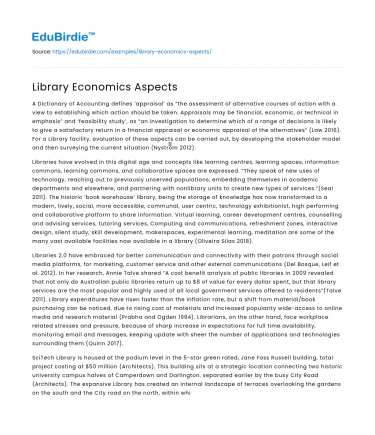A Dictionary of Accounting defines ‘appraisal’ as “the assessment of alternative courses of action with a view to establishing which action should be taken. Appraisals may be financial, economic, or technical in emphasis” and ‘feasibility study’, as “an investigation to determine which of a range of decisions is likely to give a satisfactory return in a financial appraisal or economic appraisal of the alternatives” (Law 2016). For a Library facility, evaluation of these aspects can be carried out, by developing the stakeholder model and then surveying the current situation (Nyström 2012).
Libraries have evolved in this digital age and concepts like learning centres, learning spaces, information commons, learning commons, and collaborative spaces are expressed. “They speak of new uses of technology, reaching out to previously unserved populations, embedding themselves in academic departments and elsewhere, and partnering with nonlibrary units to create new types of services.”(Seal 2011). The historic ‘book warehouse’ library, being the storage of knowledge has now transformed to a modern, lively, social, more accessible, communal, user centric, technology exhibitionist, high performing and collaborative platform to share information. Virtual learning, career development centres, counselling and advising services, tutoring services, Computing and communications, refreshment zones, interactive design, silent study, skill development, makerspaces, experimental learning, meditation are some of the many vast available facilities now available in a library (Oliveira Silas 2018).
Save your time!
We can take care of your essay
- Proper editing and formatting
- Free revision, title page, and bibliography
- Flexible prices and money-back guarantee
Libraries 2.0 have embraced for better communication and connectivity with their patrons through social media platforms, for marketing, customer service and other external communications (Del Bosque, Leif et al. 2012). In her research, Annie Talve shared “A cost benefit analysis of public libraries in 2009 revealed that not only do Australian public libraries return up to $8 of value for every dollar spent, but that library services are the most popular and highly used of all local government services offered to residents”(Talve 2011). Library expenditures have risen faster than the inflation rate, but a shift from material/book purchasing can be noticed, due to rising cost of materials and increased popularity wide-access to online media and research material (Prabha and Ogden 1994). Librarians, on the other hand, face workplace related stresses and pressure, because of sharp increase in expectations for full time availability, monitoring email and messages, keeping update with sheer the number of applications and technologies surrounding them (Quinn 2017).
SciTech Library is housed at the podium level in the 5-star green rated, Jane Foss Russell building, total project costing at $50 million (Architects). This building sits at a strategic location connecting two historic university campus halves of Camperdown and Darlington, separated earlier by the busy City Road (Architects). The expansive Library has created an internal landscape of terraces overlooking the gardens on the south and the City road on the north, within which variety of learning and study spaces have been accommodated to suit different usages (Architects). Johnpaul Cenzato, the Academic Liaison Librarian was available to quote details about the library: It supports the Faculty of Agriculture and Environment: Architecture, Design & Planning: Engineering and Information Technologies: the Sydney Medical School and Faculty of Veterinary Sciences. Furthermore, he added that the library alone has a footprint area of 3806 sqm, with around 600 seats, 147 computer stations, 85,000 non serial items and 1270 serials. The facility is maintained by 13.6 FTEs at information counters, helpdesks, and back office management (Cenzato 2019).






 Stuck on your essay?
Stuck on your essay?

